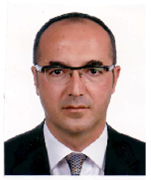Day 1 :
Keynote Forum
Grzegorz Sawicki
University of Saskatchewan, Canada
Keynote: Low-dose multitarget suppression of cardiacischemia/reperfusion pathology for improved physiological outcome
Time : 09:30-09:55

Biography:
Dr. Grzegorz Sawicki has completed his PhD in 1989 from Medical University in Wroclaw (Poland) and post-doctoral studies from University of Kentucky (USA) and University of Alberta (Canada). Currently he is Professor of Pharmacology at University of Saskatchewan (Canada). He has published more than 100 papers and book chapters.
Abstract:
Although the full molecular basis for myocardial injury triggered by myocardial infarction (MI) or oxidative stress following ischemia/reperfusion (I/R) remains unknown, contractile protein degradation by proteolytic enzymes appears to beinvolved. This theory is supported by discoveries from my laboratory and others:
(1) During I/R,matrix metalloproteinase-2 (MMP-2) activity is increased and degrades contractile proteins,including cardiac myosin light chain 1 and 2 (MLC1 and MLC2);
(2) I/R triggers chemical modifications such as phosphorylation and nitration/nitrosylation of contractile proteinsthat increase their degradation by MMP-2.
More recent evidence in my lab shows that, in addition to the pathological role of MMP-2 in I/R, MMP-2 can also regulate MLC levels under physiological conditions. I have evidence showing that robust inhibition of MMP-2 activity increases MLC levels (impairing MLC turnover) resulting in increased contractility above homeostatic levels (normal). This emphasizes the importance of only targeting pathological activity while maintaining physiological homeostasis. I have also shown that I/R increases phosphorylation and nitration/nitrosylation of MLC proteins leading to increased degradation by MMP-2. These MLC modifications play important physiological roles in addition to targeting the protein for degradation. Nitration of MLC has been reported in the process of vascular aging, and the phosphorylation of MLC2 controls the sensitivity of myofilaments to calcium in the regulation of heart contractility. Thus, maintaining the physiological activity of MMP-2 and functional MLC modifications while simultaneously providing protection from I/R is a difficult set of tasks.
I suggest, that in addition to the existing approaches in clinical practice for protection and treatment of heart injury from MI or I/R; simultaneous pharmacological suppression of MMP-2 activity and MLC nitration/nitrosylation/phosphorylation will provide improved protection of the heart from ischemic injurywhile limiting drug associated side effects.My studies have shown that a mixture of low concentrations of potential therapeutic agents (inhibitors of MMP-2 activity and MLC nitration/nitrosylation/phosphorylation)act in a synergistic mannerto provide protection from reperfusion injury. Thus, development of a “drug cocktail” or a “super pill” to protect the hearts of human patients from I/R injury may be a legitimate approach. Additional drugs that target different pathways should also be explored for their potential to act synergistically for ultimate protection. Drugs such as inhibitors of apoptosis, c-Jun N-terminal kinases (JNK), glycogen synthase kinase (GSK) or modulators of energy metabolism may also prove beneficial.
Because the basic molecular and cellular mechanisms of all I/R injury and protection are essentially similar throughout the body, this concept is important to all pathologies involving I/R; including transplantation or reattachment of limbs.
Keynote Forum
Vladimir S. Naumenko
Institute of Cytology and Genetics, Russia
Keynote: Neurotrophic factors in the regulation of behavior
Time : 11:00-11:25

Biography:
Dr. Naumenko became Head of the Department of Behavioral Neurogenomics at the Institute of Cytology and Genetics in 2014 followed by defense of doctoral (Dr.Sc.) thesis in physiology in 2012. He completed his Ph.D. in physiology at the Institute of Cytology and Genetics in 2006 after he graduated from Novosibirsk State University as molecular biologist in 2005. He joined the Department of Behavioral Neurogenomics while he was student in 2002 and began to study the role of different types of serotonin receptors in the regulation of genetically determined defensive behavior in animal models. Now he studies the molecular mechanisms of serotonin receptor interaction and their role in the mechanisms of aggressive behavior and depression. Dr. Naumenko is also studying the cross-talk between neurotrophic factors and brain neurotransmitters in the regulation of different kind of behavior.
Abstract:
Among large family of the neurotrophines involved in the growth and survival of neurons the brain-derived neurotrophic factor (BDNF) and glial cell line-derived neurotrophic factor (GDNF) attract particular attention due to their role in the behavioral control. This talk will summarize the data on the involvement of brain neurotrophic factors in the control of normal and pathological behavior. It will provide evidence on the implication of BDNF in epigenetically and genetically defined behavior in different animal models. Particularly, the talk will be focused on the BDNF effects on i) prenatal ethanol and stress exposure-induced behavioral disorders; ii) depressive-like behavior; iii) genetically determined aggressive behavior. It will also provide some data on the BDNF and GDNF role in the regulation of sensorimotor gating deficiency as well as GDNF involvement in the mechanisms of depression and learning. The cross-relation between neurotrophines and brain serotonergic and dopaminergic systems will be discussed
Keynote Forum
Connie Medlen
University of Pretoria, South Africa
Keynote: Medicinal application of potassium humate
Time : 09:55-10:20

Biography:
Van Rensburg obtained a BSc (agric) in Microbiology in 1964, an MSc in 1982 and a Ph.D in Immunology in 1986 (at the age of 43). Up till now she has been employed by the University of Pretoria for 43 years after which she retired. Twenty nine MSc and nine PhD completed their studies under her supervision. After 4 years of retirement she returned to the University of Pretoria, Faculty of Medical Sciences as Research Mentor. She has published 128 research papers in ISI accredited international journals and presented at 44 International Conferences.
Abstract:
Mechanistic studies done by my research group on brown coal derived potassium humate indicates that potassium humate inhibits the activation of complement, the expression of adhesion molecules and the release of cytokines associated with inflammation. In studies done on rats we found that potassium humate is safe at an oral dosage of up to 1g per kg. According to toxicity studies by us in rats potassium humate has no effect on the safety parameters when administered to rats at a dosage of 1g per day nor did it have any effect on the pups if administered to pregnant female rats at 500mg per day. Efficacy studies indicated that this product, at an oral dosage of 60mg/kg, inhibits a delayed type hypersensitivity reaction in rats immunised with sheep red blood cells as well as a carrageenan-induced oedema and a graft-vs-host reaction. We also found that the product inhibited a contact hypersensitivity reaction in rats sensitised to dinitrofluorobenzene. In these studies potassium humate compared favourably with indomethacin and prednisolone. Interestingly, immune-incompetent rats (induced with cyclophosphamide treatment in the graft-vs-host experiment) treated with potassium humate did not suffer from the normal weight loss as was the case with rats treated with cyclophosphamide alone.
- Track 1: Clinical Pharmacology and Receptor Theory
Track 2: Neuropharmacology and its Advances
Track 4: Pharmacogenetics and Pharmacogenomics
Track 9: Vascular Pharmacology

Chair
Grzegorz Sawicki
University of Saskatchewan, Canada
Session Introduction
Sudhindra R Gadagkar
Midwestern University,USA
Title: Computational tools for fitting the Hill equation to dose–response curves

Biography:
Gadagkar received his Ph.D from Dalhousie University, Canada in 1997. Subsequently, he did post-doctoral research in the field of computational biology at Arizona State University, USA. He is an Associate Professor at Midwestern University, Arizona, USA. He teaches Genetics and Statistics from a biomedical perspective, and his research is in the general area of molecular evolutionary biology. Dr. Gadagkar has published in journals such as Genetics, Molecular Biology and Evolution, BMC Evolutionary Biology, Journal of Molecular Evolution, and more recently in Fly and Journal of Pharmacological and Toxicological Methods. He is an Academic Editor for the journal, PLOS ONE.
Abstract:
Biological response curves commonly assume a sigmoidal shape that can be approximated well by means of the 4-parameter nonlinear logistic equation, also called the Hill equation. However, estimation of the Hill equation parameters typically requires access to commercial software or the ability to write computer code. Here we present two user-friendly and freely available computer programs to fit the Hill equation — a Solver-based Microsoft Excel template and a stand-alone “point and click” program, called HEPB. Both computer programs use the iterative method to estimate the Hill equation parameters, EC50 and the Hill slope, while constraining the values of the minimum and maximum asymptotes of the response variable. While the Excel template allows the user to work in the familiar Microsoft Office environment, HEPB, in addition to fitting the Hill equation, also computes the prediction band for the data at a user-defined level of confidence, and determines the EC50 value for each of the limits of this band to give boundary values that help objectively delineate sensitive, normal and resistant responses to the drug being tested. Furthermore, HEPB also has the option to simulate response values based on the original data and the fit of the Hill equation to that data. Both programs were tested by analyzing twelve datasets that varied widely in data values, sample size and slope, and were found to yield estimates of the Hill equation parameters that were essentially identical to those provided by GraphPad Prism and nls, the statistical package in the programming language R.
Ahmet Hacimuftuoglu
Ataturk University, Turkey
Title: Neurotransmitter sensing by high temporal and spatial resolution

Biography:
He graduated from Medical Faculty of Istanbul (Capa) University in 1999. Ahmet Hacimuftuoglu has completed his Ph.D at the age of 27 years from Ataturk University and postdoctoral studies from Ohio State University School of Medicine. He set up the “in vivo voltammetry laboratory” in Ataturk University, in 2008. He is the head of the department of Medical Pharmacology in Ataturk University. He has published more than 50 papers in SCI journals and also has 4 patents and serving as an editorial board member of Turkish Journal of Biology and also serving as executive committee member of TUBITAK Biotechnology in Turkiye. He mainly works on glutamate and psychoneuropharmacology.
Abstract:
Neurotransmitters mediate communication between neurons and non-neuronal cells. Changings in neurotransmitter levels in the synaptic area can cause or aggravate central nervous system (CNS) disorders. In the past, detecting directly of these levels has been limited in its temporal and spatial resolution because of their nature of chemical signaling and their structures. Minimally invasive techniques for monitoring brain chemistry in vivo provided better understanding of neuropharmacology of CNS disorders. For monitoring and sampling brain chemistry; voltammetric electrodes, microdialysis and related analytical techniques had been used. Microdialysis, compared to voltammetry, offers lower temporal and spatial resolution. Glutamate is a principle neurotransmitter. But it also has neurotoxic effects. In our studies we used voltammetric electrodes for detecting glutamate activities in synaptic area. Different brain areas were chosen with stereotaxy three dimensionally for each experimental disease models. We used different glutamate transporter activator or inhibitor drugs to change glutamate levels in synaptic area in different animal models. To better understand the role of glutamate in neurodegenerative disease models, we used enzyme-based microelectrodes that were selective for glutamate and measures with fast temporal and high spatial resolution. Also our understanding on drugs and their action mechanisms are increasing by this method.
Ming-Chao Huang
Taipei Veterans General Hospital, Taiwan
Title: Treatment with nerve graft and acidic fibroblast growth factor enhance neuron survival and functional recovery in cervical root injury

Biography:
Ming-Chao Huang graduated from Taipei Medical University in 1984 and received Ph.D in Tokyo Women’s Medical University in 1997. The current position is Section Chief in the Neurological Institute of Taipei Veterans General Hospital and President of Taiwan Neurosurgical Society for Spine. Dr. Huang focuses on disease of spine, peripheral nerve, especially in brachial plexus injury, and brain tumor, both clinical and research. In brain tumor, he studies the effect and mechanism of anti-angiogenesis therapy. He also achieved success in the treatment brachial plexus injury and is now investigating its pain mechanism.
Abstract:
Neurotrophic factors are crucial for neuron survival and axon regeneration. Among them, acidic fibroblast growth factor (aFGF) is a normal constituent of the spinal cord and is expressed in motor neurons and primary sensory neurons. It is involved in repairing process after tissue damage. Our studies demonstrate that aFGF has beneficial effects in the treatment of cervical root injury, which is currently considered by most to be beyond surgical repair and medical treatment.In the last decade,we developed a repair technique by bridging severed nerve roots and the spinal cordwith autologous nerve graft and addingaFGFmixed infibrin glue. The fibrin glue not only acts as a tissue glue but also ensures slow-release of the aFGF. We achieved functional recovery in animal experiments as well as in clinical trial. In a series of animal experiments, the outcomeof both motor and sensory function was markedly improved.The improvement was related to the increase of both motor and sensory neuron survival, even in the worst clinical scenario, such as repairingin a chronic stage, or repairing ventral root only. In clinical trial, significant functional recovery were also observed, including muscle power and mechanical sensation.We believe that besides surgery, the addition of aFGF may play an important role not only in enhancing axonal regeneration but also in promoting neuronal survival; which arethe key factorsfor functional recovery.
Young Hyo Kim
Inha University College of Medicine, Republic of South Korea
Title: Benzaldehyde suppresses murine allergic asthma and rhinitis

Biography:
Young Hyo Kim is an assistant professor at the Department of Otorhinolaryngology, Inha University, College of Medicine. His special research interests are allergy (clinical, basic and transitional research) and space medicine. He has published more than 35 papers in the international reputed journals (Science Citation Index journals).
Abstract:
To evaluate the antiallergic effects of oral benzaldehyde in a murine model of allergic asthma and rhinitis, we divided 20 female BALB/c mice aged 8–10 weeks into nonallergic (intraperitoneally sensitized and intranasally challenged to normal saline), allergic (intraperitoneally sensitized and intranasally challenged to ovalbumin), and 200- and 400-mg/kg benzaldehyde (allergic but treated) groups. The number of nose-scratching events in 10 min, levels of total and ovalbumin-specific IgE in serum, differential counts of inflammatory cells in bronchoalveolar lavage (BAL) fluid, titers of Th2 cytokines (IL-4, IL-5, IL-13) in BAL fluid, histopathologic findings of lung and nasal tissues, and expressions of proteins involved in apoptosis (Bcl-2, Bax, caspase-3), inflammation (COX-2), antioxidation (extracellular SOD, HO-1), and hypoxia (HIF-1α, VEGF) in lung tissue were evaluated. The treated mice had significantly fewer nose-scratching events, less inflammatory cell infiltration in lung and nasal tissues, and lower HIF-1α and VEGF expressions in lung tissue than the allergic group. The numbers of eosinophils and neutrophils and Th2 cytokine titers in BAL fluid significantly decreased after the treatment (P < 0.05). These results imply that oral benzaldehyde exerts antiallergic effects in murine allergic asthma and rhinitis, possibly through inhibition of HIF-1α and VEGF.
Arquimedes Gasparotto Junio
Universidade Federal da Grande Dourados, Brazil
Title: Cardiovascular protective effects of Casearia sylvestris Swartz in Swiss and C57BL/6 LDLr-null mice undergoing high fat diet

Biography:
Arquimedes Gasparotto Junior has completed his Ph.D. at the age of 35 years from Federal University of Paraná and postdoctoral studies from Federal University of Santa Catarina. He is chief researcher in preclinical pharmacology and associate professor of medical school of the Federal University of Grande Dourados, Brazil. He has published three books and more than 25 papers in reputed journals and serving as an editorial board member of repute.
Abstract:
In this study was shown the cardioprotective effects of the methanolic extract obtained from Casearia sylvestris (MECS) using Swiss and C57BL/6 LDLr-null mice undergoing high fat diet (HFD). Dyslipidemia and atherogenesis were induced by the administration of HFD for 4 weeks. The MECS was administered orally at doses of 250 and 500 mg/kg, for two weeks, starting from the 2nd week of HFD. The gain in body weight and systolic blood pressure (SBP) were measured weekly over the four week study. At the end of the experiments the levels of triglyceride (TG), total cholesterol (TC), high-density lipoprotein (HDL-C), low-density lipoprotein (LDL-C) and very low-density lipoprotein (VLDL-C) were measured. Aldosterone, vasopressin and angiotensin converting enzyme (ACE) activity were also evaluated. The renal function, atherogenic index serum (AIS) and in vitro antiplatelet activity were investigated. Additionally, histopathological analyzes were performed to determine the intima-media thickness (IMT) and intima media ratio (IMR) in aorta samples. The HFD induced dyslipidemia and structural changes in the aortic wall, including raising of the systolic blood pressure in LDLr-null mice. In addition, we observed an increase in lipid peroxidation accompanied by a reduction of serum nitrite. The treatment with MECS was able to prevent the increase of SBP, TC, LDL-C, VLDL-C and triglycerides levels and increase HDL-C in Swiss and LDLr-null mice. These effects were accompanied by a significant reduction in oxidative stress. Moreover, AIS, IMT and IMR were significantly reduced in MECS-treated mice, and the extract was able to reduce platelet aggregation in vitro.
Vladimir S Naumenko
Institute of Cytology and Genetics, Russia
Title: Effect of GDNF on depressive-like behavior, spatial learning and key genes of the brain dopamine system in genetically predisposed to behavioral disorders mouse strains

Biography:
Dr. Naumenko became Head of the Department of Behavioral Neurogenomics at the Institute of Cytology and Genetics in 2014 followed by defense of doctoral (Dr.Sc.) thesis in physiology in 2012. He completed his Ph.D in physiology at the Institute of Cytology and Genetics in 2006 after he graduated from Novosibirsk State University as molecular biologist in 2005. He joined the Department of Behavioral Neurogenomics while he was student in 2002 and began to study the role of different types of serotonin receptors in the regulation of genetically determined defensive behavior in animal models. Now he studies the molecular mechanisms of serotonin receptor interaction and their role in the mechanisms of aggressive behavior and depression. Dr. Naumenko is also studying the cross-talk between neurotrophic factors and brain neurotransmitters in the regulation of different kind of behavior
Abstract:
Insufficient drug uptake by solid tumors remains the major problem for systemic chemotherapy. Although anticancer drug effects are dose-dependent, dose-escalationhas resulted in limited survival benefit with increased toxicities. Loco-regional treatments, offering dramatically higher drug concentrations in tumor tissues while minimizing systemic toxicity, thought to be a solution, but survival benefits are still not sufficient. We have proposed that the main obstacle preventing local drug extraction by the tumor cells is the hydrophilic nature of the drug formulations themselves, which prevents partitioning through membrane lipid bilayer. To overcome this obstacle we have developed an approach for drug hydrophobization in which the drug is linked to a hydrophobic moiety by highly labile chemical linkages [termed rapidly reversible hydrophobization (RRH)]
Grzegorz Sawicki,
University of Saskatchewan, Canada
Title: Simultaneous subthreshold inhibition of MMP, MLCK a nd NOS activities protects cardiomyocytes from contractile dysfunction induced by hypoxia-reoxygenation

Biography:
Dr. Grzegorz Sawicki has completed his PhD in 1989 from Medical University in Wroclaw (Poland) and post-doctoral studies from University of Kentucky (USA) and University of Alberta (Canada). Currently he is Professor of Pharmacology at University of Saskatchewan (Canada). He has published more than 100 papers and book chapters.
Abstract:
Injury of the myocardium during ischemia/reperfusion (I/R) is a complex and multifactorial process including uncontrolled protein phosphorylation, increased production of reactive oxygen species such as nitric oxide and peroxynitrite and increased contractile protein degradation by matrix metalloproteinases (MMPs). It has been shown that inhibition of MMP-2, myosin light chain kinase (MLCK) or nitric oxide synthase (NOS) can protect the heart from contractile dysfunction triggered by I/R. In this study, we show that co-administration of a mixture of low (subthreshold) concentrations of inhibitors for MMP activity (doxycycline), MLC1 phoshorylation (ML-7 inhibitor of MLCK) and nitric oxide synthase (1400W or L-NAME) protects cardiomyocytes from hypoxia-reoxygenation (H-R) induced contractile dysfunction. Isolated cardiomyocytes were subjected to 2 min hypoxia and 20 min reoxygenation (H-R) in the presence or absence of the inhibitor cocktail. Contractility of cardiomyocytes was expressed as myocyte peak shortening. Inhibition of MMP-2 by doxycycline (25-100 µM), MLCK by ML-7 (0.5-5 µM) and NO synthase with L-NAME (25-100 µM) or 1400W (25-100 µM) protected myocyte contractility after H-R in a concentration dependent manner. This led to full recovery of contractile dysfunction induced by H-R. Mixture of NOS, MMP-2 and MLCK inhibitors in subthreshold or lower concentrations protected cardiomyocyte contractility and MLC1 from degradation by MMP-2. The results of this study suggest that administration of a mixture of low (subthreshold) concentrations of doxycycline, ML-7, and 1400W or L-NAME might to be a novel strategy for protecting cardiomyocyte contractility from oxidative stress induced by coronary revascularization during cardiopulmonary bypass.

Biography:
Ali Parlar has completed his Ph.Din 2001 from Ankara University. He iscurrently assistant professor at pharmacology department in Faculty of Medicine, Adıyaman University, Adıyaman, Turkey. He has research experience of 4 years and has 3 articles. His research areas are inflammation and ischemia/reperfusion.
Abstract:
The present study aimed to investigate the potential of anti-inflammatory effects of specific CB2 agonist, GW405833, in a rat model of acute inflammation, and along with effects on leukocyte recruitment, cytokines levels, and oxidative stress. The anti-inflammatory activities of GW405833 were assessed by measuring paw oedema induced by carrageenan, and capsaicin, myeloperoxidase (MPO) activity, peritonitis model and cytokine levels. Further, oxidative stress was evaluated by determining glutathione (GSH) levels and malondialdehyde (MDA) concentration. The results showed that GW405833 (3 mg/kg) significantly reduced carrageenan-induced paw oedema, and clearly inhibited capsaicin -induced paw oedema. It also inhibited the recruitment of total leukocytes and neutrophils, mieloperoxidase (MPO) activity, and reversed nearly to the normal levels the increased tumor necrosis factor-α (TNF-α), interleukin-1β (IL-1β) levels, and malondialdehyde (MDA) concentration during carrageenan-induced acute inflammation. These results suggest that GW405833 suppresses the inflammatory response by inhibiting neutrophil migration that is partly mediated by reduction in IL-1β and TNF-α levels and oxidative stress. In conclusion, the activation of CB2 receptor, by specific agonist, has a major role in peripheral inflammations, and in the near future, maybe seen new pharmacologic approaches of peripheral cannabinoidergic system as a promising alternative to treat inflammation diseases.

Biography:
Rekha Shenoy is currently working as an associate professor in the Department of Pharmacology at Manipal College of Pharmaceutical Sciences, Manipal University. She has been the recipient of three research grants funded by All India Council of Technical Education [AICTE] and Department of Biotechnology [DBT], New Delhi. Her areas of research interest are pharmacology of wound healing and role of antioxidants on healing status, inflammatory disorders and colon cancer. She has fifteen papers in impact factor journals to her credit. Dr Shenoy is happily married to Dr Arun T S, Manager- Quality Assurance, Ecron Acunovaand blessed with a son.
Abstract:
The general perception of herbal medicines as a safer alternative to allopathic drugs often leads to self-medication. Concomitant usage of herbal remedies (by chance or choice) with prescription medicines can lead to un-intended interactions modifying pharmacological properties of either drug, which could lead to potential treatment failure. We designed a study, where metformin [MET], an extensively prescribed anti-diabetic medication was evaluated with commonly used Indian herbal remedies, Sallaki (SAL) and Ashwagandha(ASH). Pharmacokinetic and pharmacodynamics profiles were determined under normal and insulin resistance conditions in rodents. A sensitive bioanalytical method was developed and validated in-house for the determination of metformin. Pharmacokinetic and pharmacodynamic evaluations were performed by using Winnonlin (v 5.3). The evaluations included estimation of Cmax, tmax, AUC0-t, AUC0-∞, Vd, Cl, t1/2 and Kel by non-compartmental pharmacokinetic analysis and estimation of plasma glucose concentrations at the scheduled time along with PK sampling. The data assessment involved plotting of response (plasma glucose) vs time and subsequent group wise comparison of the obtained data in both actual and percent-normalized form. The analysis of response vs time data was performed by non-compartmental pharmacodynamics analysis WinNonlin version 5.3. The PK-PD study demonstrated that increased obesity and associated pathological changes led to increased systemic exposure of metformin. In the absence of herbs, MET glucose profile was stable with a narrow range of plasma glucose variations. ASH does not affect metformin pharmacokinetics. The Cmaxwas reduced by 37% and AUC by 47%. Administration of SAL reduces the bioavailability of metformin. In presence of ongoing SAL treatment, higher doses of MET could be required to produce required effect. This study assumes greater importance considering the fact that the chosen herbal remedies and the drug are used for the treatment of chronic conditions. Notmany interactions are reported for metformin owing to its physico-chemical and metabolic characteristics. Our findings demonstrate that concomitant usage of metformin with sallaki may adversely affect the outcome or may result in needless increase in dosage.
Seyfullah Oktay Arslan
Yildirim Beyazit Universitesi, Turkey
Title: Anti- inflammatory effects of cannabinoid 2 receptor agonist, GW405833, in a model of carrageenan-induced acute inflammation of the rat paw

Biography:
Seyfullah Oktay ARSLAN has completed his Ph.D in 1995 from Istanbul University. He is the director of pharmacology at Faculty of Medicine, Yıldırım Beyazıt University, Ankara, Türkiye. He has research experience of 25 years and has published over 30 papers in reputed journals. His areas of research interest are inflammation, asthma, and ischemia/reperfusion. He performed the member of Drug Bioequivalence Commission of Health Ministry in 2004-2010 years. In addition he has GLP and GMP knowledge experiences.
Abstract:
In our previous studies, evaluations were made on some effects of the cannabinoid (CB)2 receptor activations’ during the inflammatory processes of peripheral tissues after intestinal ischemia/reperfusion . This study was designed to investigate the anti-inflammatory effects of selective CB2 receptor agonist, GW405833, in the carrageenan paw oedema test of rats. Mix type and neurogenic inflammation were induced by giving an intraplantar injection of carrageneen (50 µl, 1%) or capsaicin (50 µl, 0.1%) respectively, into the hind left paw. The study was designed in two series of groups: In the first group, plasma extravasations were measured via Evans blue dye method. The dye was injected in the tail vein 15 min before the end of the experiments. The anaesthetized animals were sacrificed by decapitation, and hind paws were incubated with formamide, and then the extracted dye was measured by spectrophotometry at 620 nm. In the second group, paw thickness was measured with electronic digital callipers, prior to and 4 h following carrageenan or 1 h following capsaicin administration, which corresponds to peak oedema. The anti-oedematous effects of GW405833 (3 mg/kg, i.v.) were compared to diclofenac (10 mg/kg, i.v.), a nonselective cyclooxygenase inhibitor, 15 min before these intraplantar injections of inflammatory agents. CB receptor involvement in the anti-inflammatory effects of GW405833 was evaluated by administration of the CB2 receptor antagonist, AM630 (1 mg/kg, i.v., 5 min before CB2 agonist injection). Pretreatment of rats with both GW405833 and diclofenac significantly attenuated carrageenan-induced paw oedema (P < 0.05) compared to vehicle-treated group. Likewise, GW405833 strongly inhibited capsaicin induced-oedema. In the second group, GW405833 significantly decreased the plasma extravasations in both carrageenan-induced mix type inflammation and capsaicin-induced neurogenic inflammation of rat paw. CB2 receptors mediate the anti-oedematous and anti-plasma extravasations effects of GW405833. The pretreatment with AM630 clearly reversed the all those effects of GW405833, which suggests a significant interaction between GW405833 and AM630. These results suggest that the GW405833 reduces inflammation through the activation of CB2 receptors when administered after carrageenan, and that effect seems to be related to the suppression of neurogenic inflammation.
Alex Joseph
Manipal University, India
Title: Synthesis and in vitro anticancer studies of novel coumarin substituted thiazolidin-4- ones

Biography:
Alex Joseph has completed his Ph.D at the age of 35 years from Manipal University. He is presently working as Associate Professor in Department of Pharmaceutical Chemistry, Manipal College of Pharmaceutical Sciences, Manipal University. He has published more than 35 papers in reputed journals and serving as an editorial board member of various journals
Abstract:
Thiazolidin-4-ones and coumarins are important pharmacodynamic heterocyclic scaffolds which have been reported to possess potent anti-inflammatory and anticancer properties. The combination of two pharmacophores on the same molecule is a well-established approach for the designing of potent molecules and further substitution on these scaffolds may further enhance their activity. Therefore a series of coumarin substituted thiazolidin-4-ones were synthesized and evaluated for their anticancer activity. Initially 3-acetylamiocoumarin was synthesized by cyclocondensation of salicyladehyde with N-acetylglycine. Acid hydrolysis of 3-acetylaminocoumarin afforded 3-aminocoumarin. Finally one pot reaction of 3-aminocoumarin and thioglycolic acid with different aldehydes in dry toluene yielded the corresponding coumarin substituted thiazolidin-4-ones. Structures of final compounds were confirmed by IR, NMR and Mass techniques. Among the fifteen coumarin substituted thiazolidin-4-ones screened for their in vitro cytotoxic effect on T47D and HeLa human cancer cell lines, compounds, 2-(3-fluorophenyl)-3-(2-oxo-2H-chromen-3-yl)thiazolidin-4-one (NKT-7), 2-(2-fluorophenyl)-3-(2-oxo-2H-chromen-3-yl)thiazolidin-4-one (NKT-8) and 2-(5-methylthiophen-2-yl)-3-(2-oxo-2H-chromen-3-yl) thiazolidin-4-one (NKT-14) exhibited maximum cytotoxicity with IC50 values below 2.5 µg/ml. Other moderately active compounds were NKT-4, NKT-5, NKT-6, NKT-7, NKT-13 and NKT-15 showing IC50 value between 3.45-14.67 µg/ml. The most active compounds NKT-7, NKT-8 and NKT-14 exhibited apoptosis mediated cell death as confirmed by Hoechst staining studies. Thiophen substituted thiazolidin-4-ones and fluoro/bromo/nitro phenyl substituted thiazolidin-4-ones were found to more cytotoxic than other thiazolidinones. These novel leads molecules can be further modified and screened to improve their anticancer activity.
Alaa Abousetta
Suez Canal University, Egypt
Title: The effects of concomitant Ginkgo intake on noise induced Hippocampus injury. Possible auditory clinical correlate

Biography:
Alaa Abousetta has completed his MD " Doctorate of Audiological Medicine" at the age of 35 years from Ain Shams University, Cairo, Egypt. He is currently appointed as Associate Professor and the head of Audiovestibular unit at Faculty of Medicine Suez Canal University, Egypt. He has published around 20 papers in reputed journals and serving as editorial board member of repute. In addition, he has helped in inauguration of Audiovestibular units as well as academic degrees in Egypt and the Arab world.
Abstract:
This study was conducted to determine the injurious effects of noise on the hippocampus, and to show whether Ginkgo biloba (Gb) has any modulatory effect on hippocampal injury. Fifteen adult male albino rats were divided into three groups; control group, noise group and protected group. The noise group was exposed to 100 dB Sound pressure level (SPL) white noise, six hours/day for four consecutive weeks. The protected group was exposed to the same noise level with the administration of Gb extract to the animals (50 mg/kg daily) for 4 weeks. In the noise exposed group, both pyramidal cell layer and dentate gyrus (DG) granular cell layer showed a decrease in thickness with loss and degeneration of many cells. The protected group showed preservation of many parameters as compared to the noise group i.e. increase in thickness of Cornu Ammonis area3 (CA3)&DG; increase in surface area of cells and increased vascularity. In conclusion, noise had detrimental effects on cells of Cornu Ammonis area1 (CA1), CA3 & DG of the hippocampus. In view of this finding, the clinical auditory hazardous effects in people exposed to harmful noise such as tinnitus, as well as memory disturbances and learning disabilities might have a new dimension. The administration of Gb protected the hippocampus against the injurious effect of noise. The probable mechanism and usefulness of Gb in reducing the previously mentioned effects are discussed.

Biography:
SrinivasMutalik has completed his Ph.D.in 2004 from Manipal University and postdoctoral studies from University of Queensland, Australia. He is working as Associate Professor in Manipal College of Pharmaceutical Sciences, Manipal University, India. He has good professional experience in academics and pharmaceutical industry at different capacities.Dr. Mutalik has published more than 60 papers in reputed journals and has 4 patents. He has presented papers at various national and international conferences and delivered guest lectures. He has received several research grants from various funding agencies. Dr. Mutalik’s research interests include development and evaluation of novel drug delivery systems.
Abstract:
The objective of the present work was to develop nanoparticulate sunscreen creams containing nanoparticles of a polyphenol along with classical sunscreen agents. Optimized nanoparticles exhibited desirable particle size, zeta potential and entrapment efficiency. FTIR and DSC studies revealed no interaction between polyphenol and excipients used. Transmission electron microscopy, scanning electron microscopy and atomic force microscopy revealed that the nanoparticles were spherical in shape. Optimized polyphenol nanoparticles showed excellent in vitro free radical scavenging activity. Nanoparticles did not exhibit cytotoxicity as indicated in MTT assay carried out using Vero and HaCaT cell lines. Skin permeation and skin deposition of morin from its nanoparticles was higher than from its plain form. Different sunscreen creams were formulated by incorporating nanoparticles along with zinc oxide and titanium dioxide in the cream base. Optimized creams showed excellent SPF values as determined by UV-2000S (Labsphere, USA). In in vitro skin permeation studies, skin permeation of polyphenol was considerably reduced and its skin deposition was substantially increased. In vivo skin permeation studies in rats indicated no transdermal permeation of polyphenol across the skin and excellent retention of polyphenol within the skin. Optimized sunscreen creams indicated excellent dermal safety. Optimized cream demonstrated exceptional in vivo antioxidant effect (estimation of catalase, superoxide dismutase, glutathione) in UV radiation exposed rats. The optimized sunscreen cream successfully demonstrated outstanding UV radiation protection as well as antioxidant properties.

Biography:
Masako Nagashima received her medical degree at Dokkyo Medical University, Japan (2004). She was a resident from 2004 to 2009 and has been a research associate since 2009 in the Department of Pediatrics, Jichi Medical University in Tochigi, Japan. Also, she was the chief of inpatient medicine at the International University of Health and Welfare, Japan, from 2012 to 2013. Her research focuses on neuroimaging studies of neurodevelopmental disorders.
Abstract:
Attention deficit/hyperactivity disorder (ADHD) is among the most frequent neurodevelopmental disorders. Atomoxetine (ATX) and methylphenidate (MPH) have been recommended as primary medication choices to treat inhibition- and attention-related dysfunctions in ADHD children. This study used functional near-infrared spectroscopy (fNIRS) to explore the efficacy of both medications in school-aged children with ADHD for inhibitory and attention task performance. fNIRS is a promising tool, offering robust advantages such as its compactness, affordable price, tolerance to body motion and accessibility. We monitored the oxy-hemoglobin changes in ADHD children (6 to 14 years old) during go/nogo or oddball tasks before and 1.5 h after ATX, MPH or placebo administration, in a randomized, double-blind, placebo-controlled experiment. Age-, gender- and IQ-matched healthy controls, who did not receive medications or a placebo, were also monitored. In the control subjects, the go/nogo task modulated the right inferior and middle prefrontal gyri (IFG/MFG) and the oddball task modulated the right IFG/MFG and inferior parietal cortex (IPL). In ADHD children, these activations were absent in pre-medicated conditions. The reduction in the right IFG/MFG activation was normalized by both ATX and MPH for go/nogo and oddball tasks, but the right IPL was normalized only by ATX in the oddball task. These results led us to conclude that fNIRS could visualize the differential neuropharmacological effects of both substances in the inhibitory and attentional networks: ATX to up-regulate the noradrenergic system reflected in the right IFG/MFG and IPL activations, and MPH to up-regulate the dopamine system reflected in the IFG/MFG activations.

Biography:
Anas Salem has completed his Ph.D at the age of 38 years from Assiut University and got grant from DAAD organization for doing academic researches in TUM, Munich, Germany. He has published more than 20 papers in reputed journals and serving as an member in many scientific journal.
Abstract:
Vitamin E (Vit. E) is needed for young rabbits to prevent reproductive abnormalities, abortion and poor survivability of kits. Also, exogenous progesterone (P4) is needed for rabbits to enhance early embryonic development because of inadequate corpus luteum (CL) development at this age. Hence, the aim of this study was to investigate the effect of injecting Vit. E and the combination Vit. E + P4 in young does on live body weight (LBW) gain, gestation length (GL), numbers of services/conception (NS), conception rate (CR), abortion rate (AR),litter size (LS), kit weight (KW), total litter weight (TLW), mortality rate (MR) and progesterone (P4) concentration. The group treated with Vit. E + P4 had a greater LBW gain and lesser AR at first and second pregnancy. Treatments did not have significant impact on GL and LS in the first two parities. Treatments resulted in a significantly lesser MR and greater TLW at the second parity. The Vit. E + P4 treatment resulted in a significantly lesser NS at the first parity, while Vit. E alone resulted in a significant reduction in NS at the second parity. Vit. E + P4 had a positive effect on CR at the first parity compared with controls. Vit. E alone increased CR at the second parity compared with that of the control group. The meanP4 concentration from mating to mid-pregnancy at first parity was significantly greater in the Vit. E + P4 than Vit. E and control groups. In conclusion, treatment with Vit. E + P4 at the first parity may be economically applied on rabbit farms because this treatment resulted in a greater maintenance of the first pregnancy and improved reproductive performance at the second parity as compared with results from the Vit. E treated and control groups.
